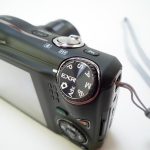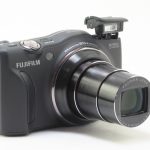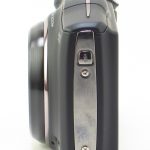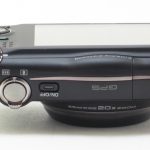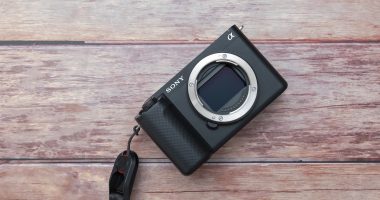 If you’re looking for a point and shoot camera with huge optical zoom capabilities, you may want to give the new FujiFilm FinePix F770EXR a look. FujiFilm packs a 20x optical zoom (25-500mm equivalent) into a very small and compact package for those who want to travel lightly. FujiFilm labels this as a travel zoom, which I’ll agree with as a camera like this isn’t something you would normally use on an everyday basis to snap a mirror shot of yourself, though you certainly can.  The F770EXR is a camera that you want to take on trips or excursions where carrying heavy camera equipment just isn’t practical.
If you’re looking for a point and shoot camera with huge optical zoom capabilities, you may want to give the new FujiFilm FinePix F770EXR a look. FujiFilm packs a 20x optical zoom (25-500mm equivalent) into a very small and compact package for those who want to travel lightly. FujiFilm labels this as a travel zoom, which I’ll agree with as a camera like this isn’t something you would normally use on an everyday basis to snap a mirror shot of yourself, though you certainly can.  The F770EXR is a camera that you want to take on trips or excursions where carrying heavy camera equipment just isn’t practical.
Again I’ll state here that this is the first camera of this type I’ve reviewed here. It’s not a mirrorless system camera with a huge sensor so my expectations for image quality are not set as high as with those cameras. My wife uses point and shoot cameras a lot and more often than not, I’m usually just pleased with the images, but not ever really blown away by them. In fact, I don’t think I’ve ever really used a point and shoot where I was completely left in awe with the image quality they produced. Because of this, I really wasn’t expecting too much despite the literature and marketing hype FujiFilm included with the F770EXR.
Does that mean I wasn’t impressed with the F770EXR? Not at all. Even though this is a type of camera I wouldn’t normally purchase myself, there are huge benefits in owning a camera like this, especially if you want to travel light.
Design of the Body & Features
 I discussed much of the body of the F770EXR here in my initial first impression post. That post covers a lot on the body and design of the camera but mainly on the overall aesthetic appearance of it. For this part of the review, I won’t be going over that again. Instead I’ll be discussing my findings of the design aspects based on real world usage.
I discussed much of the body of the F770EXR here in my initial first impression post. That post covers a lot on the body and design of the camera but mainly on the overall aesthetic appearance of it. For this part of the review, I won’t be going over that again. Instead I’ll be discussing my findings of the design aspects based on real world usage.
I’ll start off by saying that the F770EXR is very comfortable to handle and fit the contours of my hand perfectly. It’s very easy to shoot one handed and the mode dial located near the thumb grip is easily reached and used, but all the other buttons on the back of the camera will require you to hold the camera with 2 hands. This also goes for the instant movie record button which I think should have been placed in a slightly higher position to make it easier to press with your thumb or up top where you can press it with your index finger.This is possible a non-issue however as not everyone shoots one handed and if you are a two handed shooter, this makes it much easier to reach all the buttons with your thumb and makes using the camera much quicker and easier.
There was one minor annoyance, but it’s something that appears on many cameras these days. The USB port is integrated with the A/V out port so it requires the use of a special cable. I really hate this because it means that I end up having a bunch of different cables either attached to my computer or in my backpack. I’ve run across this with many of the cameras I’ve used lately and it seriously annoys me. I wish they would all use a standard USB port so that I could just use cable for all my cameras. Because of this, I end up just carrying a small SDHC card reader with me and pop out the SDHC card out of the camera every time I need to transfer photos. This keeps me from having to carry around a different cable for every camera I have with me.
Other than that, I was quite pleased with the overall design of the F770EXR. Some parts of the camera don’t quite seem as sturdy as others, but it should hold up fairly well as long as you aren’t the type to drop your camera a lot and respect the fact that this isn’t a “tough” cam and does have moving parts that can break if not taken care of properly.
Operations (Usage)
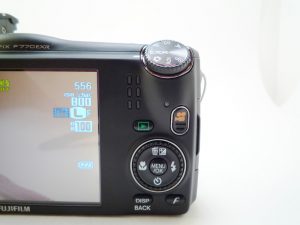 Let’s start this section off by saying that the menu system in the F770EXR is not very difficult to get into. Even if you do not read the instruction manual, you can basically figure out most of the functions in the camera by just playing with the menus and going through all the available options. This is one thing I like about point and shoot style cameras, their ease of use. FujiFilm does a good job of making the F770EXR relatively easy to use and the fact that you can select modes using the mode dial makes it infinitely more accessible to users. The more buttons and dials a camera has, the less a user has to fiddle through the software. That’s not to say that going through the menu isn’t helpful as there are tons of features you can access in the menu system that you can’t with the buttons on the camera if you don’t have it set a certain way.
Let’s start this section off by saying that the menu system in the F770EXR is not very difficult to get into. Even if you do not read the instruction manual, you can basically figure out most of the functions in the camera by just playing with the menus and going through all the available options. This is one thing I like about point and shoot style cameras, their ease of use. FujiFilm does a good job of making the F770EXR relatively easy to use and the fact that you can select modes using the mode dial makes it infinitely more accessible to users. The more buttons and dials a camera has, the less a user has to fiddle through the software. That’s not to say that going through the menu isn’t helpful as there are tons of features you can access in the menu system that you can’t with the buttons on the camera if you don’t have it set a certain way.
For the most part, most users will probably want to keep the camera in EXR mode. This is FujiFilms advanced auto mode which will select the camera mode and settings based on what you are shooting. This differs slight from regular Auto mode as you are also able to choose 3 other advanced shooting auto modes from the menu – Resolution Priority, High ISO & Low Noise, and D-Range Priority modes. These are actually 3 very handy presets to use. Resolution Priority is used to capture lots of detail, High ISO & Low Noise is used to capture night time shots with minimal noise, and D-Range Priority is like HDR mode where it will try to capture a whole range of tones to prevent washout.
 In EXR mode, the F770EXR does a relatively good job of choosing the correct scene mode for you. However if you’re the type who likes having control of which scene mode you want to use, you can switch over to SP (Scene Position) mode. I counted 18 different scene modes you can choose from and most seem quite useful and should be able to find a suitable scene mode for most situations you encounter.
In EXR mode, the F770EXR does a relatively good job of choosing the correct scene mode for you. However if you’re the type who likes having control of which scene mode you want to use, you can switch over to SP (Scene Position) mode. I counted 18 different scene modes you can choose from and most seem quite useful and should be able to find a suitable scene mode for most situations you encounter.
If you want even more control of your shots, you can stick the camera into M, A, S, or P modes. These are standard “manual” modes that you find with almost all cameras these days. These modes are very easy to adjust on the F770EXR thanks in part to the rotating dial around the directional buttons.
You’ll be happy to note that the F770EXR does a pretty decent job of keeping blur to a minimum thanks to its built-in image stabilization.
Since this is basically a point and shoot camera, you’ll be doing all your framing through the view screen. The screen on the F770EXR is very bright with very good resolution. Panning is quite smooth with it when in wide angle view but when zoomed in at the extreme, it can get quite jittery and you will need to hold the camera with two hands in order to stabilize the image. I don’t suggest shooting one handed when zoomed out at its max. I do wish that this was a touchscreen, not really for navigating the menu system but more for focusing and being able to select focus points. For the most part though, the F770EXR did a decent job of focusing what I needed it to focus on, usually.
All-in-all, using the camera was simple and didn’t require too learning in order to start shooting. For the most part, you’ll be able to just right in and start taking photos. You may want to read up on some of the more advanced modes and settings, but for the most part, the F770EXR does a good job of automating a lot of this for you.
There is one area which is kind of disappointing on the F770EXR and that is the lack of any creative modes. You are limited to only being able to choose different kinds of “film” like black & white, sepia, or vivid color but there is nothing in the way of what I’ve seen with other cameras like Holga/Lomography mode, retro filters, miniature mode, or even black & white mode with specific color accents. This would have been a really nice addition to the camera and I think one that a lot of consumers look for, especially if they don’t do a lot of post processing.
Photo Quality
The photo quality on the F770EXR is good, for a camera that uses a much smaller CMOS sensor. Don’t expect APS-C quality images here however as you’re not going to get it. That’s not to say that the images the F770EXR aren’t good. In fact, for most users, they will be more than happy with the results they get from this camera. I was actually surprised with the quality of the photos the F770EXR produces. These sample images below are all unedited save for resizing them for use here on the site.
I’ll start this off by showing you how wide you can get with the F770EXR. As you can see, you can get fairly wide with this (20mm equivalent).
Zooming all the way in to 20x (500mm equivalent) you can see that the camera does an overall great job of  retaining a lot of detail at this level. I’m also very impressed with how steady this shot is especially as you might know, when zoomed all the way in like this, it is very difficult to keep the camera perfectly steady. The built-in image stabilization does a great job of keeping the image blur free.
Here you can see that the F770EXR does a great job of minimizing barrel distortion. This was taken during the early evening just before sunset with no flash. Very good color rendering and you can still see a good amount of detail, even in the shadowy areas.
Here is another good example of how there is very little to no barrel distortion when wide out. This is perfect, especially if you are using the camera to take landscapes or photos of buildings in this manner. You will however notice a bit of purpling on the branches where there is a lot of contrast between the dark branches and the bright sky. This is something that occurs often though with cameras like this so it’s not that big a deal in my opinion.
Here is a close up shot I took just to test out the macro as well as how the F770EXR handles objects on different planes. I’m very impressed with how much detail there is in this photo and all the little bits and pieces the camera picked up. The F770EXR also does a great job in how it handles blurring of the background and foreground when shooting in macro mode.
Here is a shot from a concert, in a dimly lit amphitheater with no flash. The photos from this concert my wife took with the camera basically sealed the deal for me when it comes to recommending this camera to others. Not only was I very pleased with how these photos came out, but I was surprised at just how clear and bright they were unedited. You can check out the rest of this set here.
Overall, I am very impressed with the photos from the F770EXR. Sure there were times where the images produced quite a bit of noise, but I think that mainly had to do with not have the correct settings dialed in. I think for the most part, if you leave the camera in EXR mode and let the camera handle all the settings on its own, you’ll be very happy with the photos it can produce.
Final Thoughts
 In order for me to get the type of range that the FujiFilm FinePIx F770EXR gives me with some of my other cameras, I’d have to carry more than 1 lens with me and when dealing with telephoto lenses, these lenses can be quite large. That is why I am amazed by how small this camera is and the fact that it packs a 500mm equivalent focal length in such a small package. The fact that I can pocket this camera is amazing to me and that I never even really considered getting a travel zoom type camera until now. I mean for the price of most telephoto lenses, I could buy 2 or 3 of these cameras.
In order for me to get the type of range that the FujiFilm FinePIx F770EXR gives me with some of my other cameras, I’d have to carry more than 1 lens with me and when dealing with telephoto lenses, these lenses can be quite large. That is why I am amazed by how small this camera is and the fact that it packs a 500mm equivalent focal length in such a small package. The fact that I can pocket this camera is amazing to me and that I never even really considered getting a travel zoom type camera until now. I mean for the price of most telephoto lenses, I could buy 2 or 3 of these cameras.
The photos the camera produces is relatively good. For the most part, I was able to get some really good photos with the camera when set to EXR mode which is what most people will want to keep it on. The F770EXR does a good job of choosing the right scene mode for each occasion and it gets it right most of the time. In fact, it almost seemed like I was able to get better photos off EXR mode than I was able to using the manual M, A, S, P modes which is surprising.
Another factor that allows me to recommend this camera is the fact that my wife, which usually has difficulty using most of the cameras I own, found the F770EXR simple to use. She was able to just stick it in EXR and be done with it. Plus, she was also quite impressed with the photo quality as her current point and shoot “sucks” in her opinion and she would have never had been able to get the type of photos she did with her old camera as she did with the F770EXR.
The FujiFilm FinePix F770EXR makes a great second or even third camera. I wouldn’t necessarily get it as a primary camera only because I’ve grown accustomed now to larger sensored cameras and the ability to swap lenses. However, if you are happy with having point and shoot cameras as your main unit, I would give the F770EXR a good look. You’ll find that it’s small enough to carry around with you most of the time in a bag, purse, or jacket pocket but not quite small enough to fit comfortably in your pants. It has tons of advanced features and I found focusing to be quite speedy and accurate. It’s definitely a camera I would recommend to all my friends based on image quality, speed, size, ease of use, and that 20x optical zoom really comes in handy.
The FujiFilm FinePix F770EXR retails for $379.99. You can pick it up here on Amazon -Â Fujifilm FinePix F770EXR Digital Camera (Black)Â /Â Fujifilm FinePix F770EXR Digital Camera (Red)






